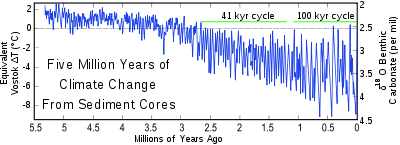Marine Isotope Stage 5
Marine Isotope Stage 5 or MIS 5 is a Marine Isotope Stage in the geologic temperature record, between 80,000 and 130,000 years ago.[1] Sub-stage MIS 5e, called the Eemian or Ipswichian, covers the last major interglacial period before the Holocene, which extends to the present day.[2] Interglacial periods which occurred during the Pleistocene are investigated to better understand present and future climate change. Thus, the present interglacial, the Holocene, is compared with MIS 5 or the interglacials of Marine Isotope Stage 11.
Substages
MIS 5, is divided into substages, divided alphabetical or with a numeric system for referring to "horizons" (events rather than periods), with MIS 5.5 representing the peak point of MIS 5e, and 5.51, 5.52 etc. representing the peaks and troughs of the record at a still more detailed level.[3]
Marine Isotope Stage (MIS) 5e
Marine Isotope Stage (MIS) 5e, called the Eemian, around 124,000–119,000 years ago, was the last interglacial period before the present (Holocene), and compared global mean surface temperatures were at least 2 °C warmer. Mean sea level was 4–6 m higher than at present, following reductions of the Greenland ice sheet. Fossil reef proxies indicate sea level fluctuations of up to 10 m around the mean. Based on the data obtained from stable oxygen isotopes of planktonic foraminifera and age constraints from corals, estimates suggest average rates of sea-level rise of 1.6 m per century. The findings are important to understand current climate change, because global mean temperatures during MIS-5e were similar to the projected climate change today.[4]
A 2015 study by sea level rise experts concluded that based on MIS 5e data, sea level rise could rise faster in the coming decades, with a doubling time of 10, 20 or 40 years. The study abstract explains: We argue that ice sheets in contact with the ocean are vulnerable to non-linear disintegration in response to ocean warming, and we posit that ice sheet mass loss can be approximated by a doubling time up to sea level rise of at least several meters. Doubling times of 10, 20 or 40 years yield sea level rise of several meters in 50, 100 or 200 years. Paleoclimate data reveal that subsurface ocean warming causes ice shelf melt and ice sheet discharge. Our climate model exposes amplifying feedbacks in the Southern Ocean that slow Antarctic bottom water formation and increase ocean temperature near ice shelf grounding lines, while cooling the surface ocean and increasing sea ice cover and water column stability. Ocean surface cooling, in the North Atlantic as well as the Southern Ocean, increases tropospheric horizontal temperature gradients, eddy kinetic energy and baroclinicity, which drive more powerful storms.[5]
See also
References
- ↑ Medley, S. Elizabeth (2011). "High Resolution Climate Variability from Marine Isotope Stage 5: a Multi-Proxy Record from the Cariaco Basin, Venezuela". University of California.
- ↑ Nicholas J. Shackleton, Maria Fernanda Sanchez-Goni, Delphine Pailler, Yves Lancelot (2002). "Marine Isotope Substage 5e and the Eemian Interglacial" (PDF). Elsevier.
- ↑ Lisiecki, L.E. (2005). "Ages of MIS boundaries". LR04 Benthic Stack. Boston University.
- ↑ E. J. Rohling, K. Grant, Ch. Hemleben, M. Siddall, B. A. A. Hoogakker, M. Bolshaw & M. Kucera (December 16, 2007). "High rates of sea-level rise during the last interglacial period". Nature Geoscience. 1: 38–42. doi:10.1038/ngeo.2007.28.
- ↑ J. Hansen, M. Sato, P. Hearty, R. Ruedy, M. Kelley, V. Masson-Delmotte, G. Russell, G. Tselioudis, J. Cao, E. Rignot, I. Velicogna, E. Kandiano, K. von Schuckmann, P. Kharecha, A. N. Legrande , M. Bauer, and K.-W. Lo (2015). "Ice melt, sea level rise and superstorms: evidence from paleoclimate data, climate modeling, and modern observations that 2◦C global warming is highly dangerous" (PDF). Atmospheric Chemistry and Physics (ACP). doi:10.5194/acpd-15-20059-2015.
